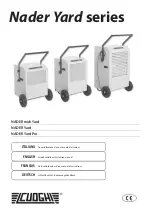
11
6.0 Operation
6.1 Controls
A solid-state controller controls valve and heater opera-
tion, monitors all critical operating conditions, and indi-
cates operating status on a 2-line LCD display operator
interface. The controller receives input data from pres-
sure switches, temperature sensors and the operator
interface. The operator interface displays information
about the dryer operating status and is used to change
the dryer operating mode.
6.2 Operating Modes
6.2.1 Automatic and Manual Advance
The drying and regeneration cycles are divided into
discrete steps. The operator selects either one of the
automatic advance modes (Energy Management, Dew
Point Control, or Fixed Cycle) or manual advance mode
(Test Cycle) through the operator interface.
Selecting any of the automatic advance modes enables
a timer in the controller to advance the program step-by-
step according to the programmed schedule.
Setting up the controller for manual advance disables the
timer and the operator can advance the program one step
at a time. This mode is used for diagnostic purposes.
6.2.2 Fixed, Energy Management or Dew Point
Control Operation
The operator interface is used to select either Fixed,
Energy Management or Dew Point Control operation. In
Fixed Cycle operation, each tower is on-line (drying) for a
fixed time period regardless of the operating conditions.
In Energy Management or Dew Point Control operation,
a tower remains on-line until the desiccant bed has been
fully utilized. For lower than designed moisture loads,
this results in longer drying cycles, longer time between
regenerations and, therefore lower energy consumption.
Energy Management or Dew Point Control operation
are optional features.
6.3 Operating Sequence Description
1. Left Tower Drying – Right Tower Regenerating
At the start of the Left Tower Drying cycle, Left Inlet
Valve
V1
opens, Right Inlet Valve
V2
closes to iso-
late the two towers. Wet, compressed air flows up
through the left tower where it is dried. The dry air
exits the dryer through the Left Outlet Check Valve
V7
.
Next, the Right Depressurization Valve
V10
is
opened and the right tower is slowly depressurized.
Air exits through exhaust muffler
M2
.
After the right tower has depressurized, the Right
Purge Valve
V4
is opened and the Blower
M
and
Heater
H1
are energized. The heated air flows
through the Right Purge Check Valve
V6
, down
through the right tower, and exits through the Right
Purge Valve
V4
. The Blower intake air is filtered
to keep dust and dirt from entering the dryer. The
Blower
M
and Heater
H1
are de-energized when
the temperature at the bottom of the right tower,
as sensed by the Right Tower Temperature Sensor
RTD2
, reaches the Heat Termination set point. This
indicates that the bed has been fully heated.
NOTE:
Blower will continue to run briefly at the end
of the Heating Step to sweep residual heat from the
heater.
The Repressurization Valve
V11
is opened. A portion
of the dry air from the left tower now flows through
Repressurization Valve
V11
. This air is throttled to
near atmospheric pressure by Repressurization/
Sweep Orifice
O2
. The dry, low pressure air flows
down through the right tower cooling the desiccant
bed, and exits through the Right Tower Purge Ex-
haust Valve
V4.
The Cooling Step continues until:
a) the right tower bed temperature falls to 150°F
or,
b) it is time to repressurize the right tower,
whichever occurs first.
NOTE:
In fixed cycle, the bed will normally be
partially cooled because the repressurization step
will occur before the bed temperature can fall to
150°F.
NOTE:
In Energy Management or Dew Point Con-
trol, as the drying time extends beyond 4 hours,
additional cooling time becomes available thus the
cooling step will frequently terminate based on tem-
perature providing complete bed cooling.
At the end of the Cooling Step, the Right Tower Purge
Exhaust Valve
V4
is closed. The right tower slowly
repressurizes to full line pressure and is ready to go
back on-line.
NOTE:
Bed cooling can be disabled by moving JP4
to the “ON” position.
2. Right Tower Drying – Left Tower Regenerating
At the start of the Right Tower Drying cycle, Right
Inlet Valve
V2
opens, Left Inlet Valve
V1
closes to
isolate the two towers. Wet, compressed air flows
up through the right tower where it is dried. The dry
air exits the dryer through the Right Outlet Check
Valve
V8
.
Next, the Left Depressurization Valve
V9
is opened
and the left tower is slowly depressurized. Air exits
through exhaust muffler
M1
.
Summary of Contents for Pneumatic Products IBP Series
Page 50: ......














































